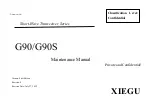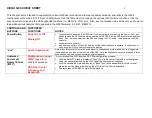
M3LT
5-2-55, Minamitsumori, Nishinari-ku, Osaka 557-0063 JAPAN
Phone: +81(6)6659-8201 Fax:
+81(6)6659-8510 E-mail: [email protected]
EM-2661-A P. 6 / 7
■
PREPARATION (E.G. M3LT-R4/A)
1 ) Mount the DIP-SW-configured M3LT on to a DIN rail.
2 ) Connect the M3LT to a simulator and a multimeter
and to a DC power source as shown below.
3 ) Turn the power supply on and wait for 10 minutes.
7
8
11
12
M3LT
Multimeter
Simulator
CJC
Sensor
+
–
DC Power Source
+ –
+
–
4
5
6
■
INPUT & OUTPUT RANGING
[Example] Setting the input to K thermocouple, 0 – 1000°C
and the output to 1 – 5V DC
1 ) Run Mode: Confirm that the green LED is blinking
(model M3LT-x/A) or the green LED turns on (model
M3LT-x/B).
2 ) Input Configuration Mode: Press MODE button for
longer than 5 seconds until the LD1 red LED is ON
and the LD2 red LED is blinking.
3 ) 0% Input Ranging: Apply the desired minimum input
level (e.g. 0µV) from the simulator and push DOWN
button until the LD1 blinks for approx. 2 sec. and then
turns OFF. When you release the button, the LD1 is
returned to ON.
The blinking LD1 means that the value is stored in
the memory. If the LED does not change, the entered
level may be inappropriate: too small a span, or out of
usable range (same for all steps).
4 ) 100% Input Ranging: Apply the desired maximum
input level (e.g. 41276µV) from the simulator and push
UP button until the LD1 blinks for approx. 2 sec. and
then turns OFF. When you release the button, the LD1
is returned to ON.
5 ) Output Configuration Mode: Push MODE button and
confirm that the LD3 red LED instead of LD2 is blink-
ing.
6 ) 0% Output Ranging: Increase or decrease the simu-
lated input until the meter shows the desired mini-
mum output level (e.g. 1V). Push DOWN button until
the LD1 blinks for approx. 2 sec. and then turns OFF.
When you release the button, the LD1 is returned to
ON.
7 ) 100% Output Ranging: Increase or decrease the
simulated input until the meter shows the desired
maximum output level (e.g. 5V). Push UP button until
the LD1 blinks for approx. 2 sec. and then turns OFF.
When you release the button, the LD1 is returned to
ON.
8 ) Run Mode: Programming complete, push MODE
button and confirm that only the LD1 green LED is
blinking.
■
ZERO & SPAN ADJUSTMENTS
After the transmitter is installed and operational, fine zero
and span tuning can be performed as explained below. Both
zero and span are adjustable within ±15%.
1 ) Run Mode: Confirm that the green LED is blinking
(model M3LT-x/A) or the green LED turns on (model
M3LT-x/B).
2 ) Fine Zero Calibration Mode: Press MODE button for 1
or 2 seconds until the LD1 red LED is ON and the LD2
green LED is blinking.
3 ) Use UP (increase) and DOWN (decrease) buttons to
adjust the output to 0%.
4 ) Fine Span Calibration Mode: Push MODE button and
confirm that the LD3 green LED instead of LD2 is
blinking.
5 ) Use UP (increase) and DOWN (decrease) buttons to
adjust the output to 100%.
6 ) Run Mode: Push MODE button and confirm that only
the LD1 green LED is blinking.
Note 1: Calibration steps can be skipped when not needed
by repeating pushing MODE buttons.
Note 2: There is no stated order of setting 0% and 100%
levels or no limitation of entering values for multiple times
within one step of Calibration Mode. Signal level is stored
each time the respective UP or DOWN button is pressed.
■
INPUT TYPE, RANGE & ACCURACY
Table 8
Thermocouple
°C
°F
MIN.
SPAN
MAXIMUM
RANGE
CONFORMANCE
RANGE
ACCURACY
*
1
MIN.
SPAN
MAXIMUM
RANGE
CONFORMANCE
RANGE
ACCURACY
*
1
(PR)
K (CA)
E (CRC)
20
20
20
0 to 1760
-270 to +1370
-270 to +1000
0 to 1760
-150 to +1370
-170 to +1000
±1.00
±0.25
±0.20
36
36
36
32 to 3200
-454 to +2498
-454 to +1832
32 to 3200
-238 to +2498
-274 to +1832
±1.80
±0.45
±0.36
J (IC)
T (CC)
B (RH)
20
20
20
-210 to +1200
-270 to +400
100 to 1820
-180 to +1200
-170 to +400
400 to 1760
±0.25
±0.25
±0.75
36
36
36
-346 to +2192
-454 to +752
212 to 3308
-292 to +2192
-274 to +752
752 to 3200
±0.45
±0.45
±1.35
R
S
C (WRe 5-26)
20
20
20
-50 to +1760
-50 to +1760
0 to 2315
200 to 1760
0 to 1760
0 to 2315
±0.50
±0.50
±0.80
36
36
36
-58 to +3200
-58 to +3200
32 to 4199
392 to 3200
32 to 3200
32 to 4199
±0.90
±0.90
±1.44
N
U
L
P(Platinel II)
20
20
20
20
-270 to +1300
-200 to +600
-200 to +900
0 to 1395
-130 to +1300
-200 to +600
-200 to +900
0 to 1395
±0.30
±0.20
±0.25
±0.25
36
36
36
36
-454 to +2372
-328 to +1112
-328 to +1652
32 to 2543
-202 to +2372
-328 to +1112
-328 to +1652
32 to 2543
±0.54
±0.36
±0.45
±0.45
*1 ) [Ac Cold Junction Compensation Error 0.5°C (0.9°F)] or ±0.1% of span, whichever is greater.
If the selected output span equals to or narrower than the one-tenth of the maximum span, add 0.2%.

























